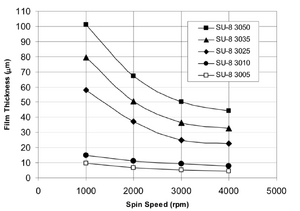SU-8: Difference between revisions
Jump to navigation
Jump to search
Created page with "SU-8 is a negative, epoxy based, near-UV photoresist designed for MEMS and other microelectronic applications. It was originally developed and patented by IBM. SU-8 is processed using standard lithography techniques. When SU-8 is exposed to UV light its molecular chains cross-link, causing the SU-8 to solidify. SU-8 is highly transparent in the ultraviolet range. This allows for the fabrication of relatively thick (hundreds of micrometers) structures with nearly vertical..." |
No edit summary |
||
| Line 1: | Line 1: | ||
SU-8 is a negative, epoxy based, near-UV photoresist designed for MEMS and other microelectronic applications. It was originally developed and patented by IBM. SU-8 is processed using standard lithography techniques. When SU-8 is exposed to UV light its molecular chains cross-link, causing the SU-8 to solidify. SU-8 is highly transparent in the ultraviolet range. This allows for the fabrication of relatively thick (hundreds of micrometers) structures with nearly vertical side walls. Two companies have licenses from IBM to sell SU-8: MicroChem and Gersteltec. | SU-8 is a negative, epoxy based, near-UV photoresist designed for MEMS and other microelectronic applications. It was originally developed and patented by IBM. SU-8 is processed using standard lithography techniques. When SU-8 is exposed to UV light its molecular chains cross-link, causing the SU-8 to solidify. SU-8 is highly transparent in the ultraviolet range. This allows for the fabrication of relatively thick (hundreds of micrometers) structures with nearly vertical side walls. Two companies have licenses from IBM to sell SU-8: MicroChem and Gersteltec. | ||
[[File:SU83000_SC.png|thumb|left|Spin curve of SU-8 3000 series. SU-8 3000 Thickness vs. Spin Speed.]] | |||
=Technical datasheets= | =Technical datasheets= | ||
Revision as of 12:18, 6 August 2025
SU-8 is a negative, epoxy based, near-UV photoresist designed for MEMS and other microelectronic applications. It was originally developed and patented by IBM. SU-8 is processed using standard lithography techniques. When SU-8 is exposed to UV light its molecular chains cross-link, causing the SU-8 to solidify. SU-8 is highly transparent in the ultraviolet range. This allows for the fabrication of relatively thick (hundreds of micrometers) structures with nearly vertical side walls. Two companies have licenses from IBM to sell SU-8: MicroChem and Gersteltec.
